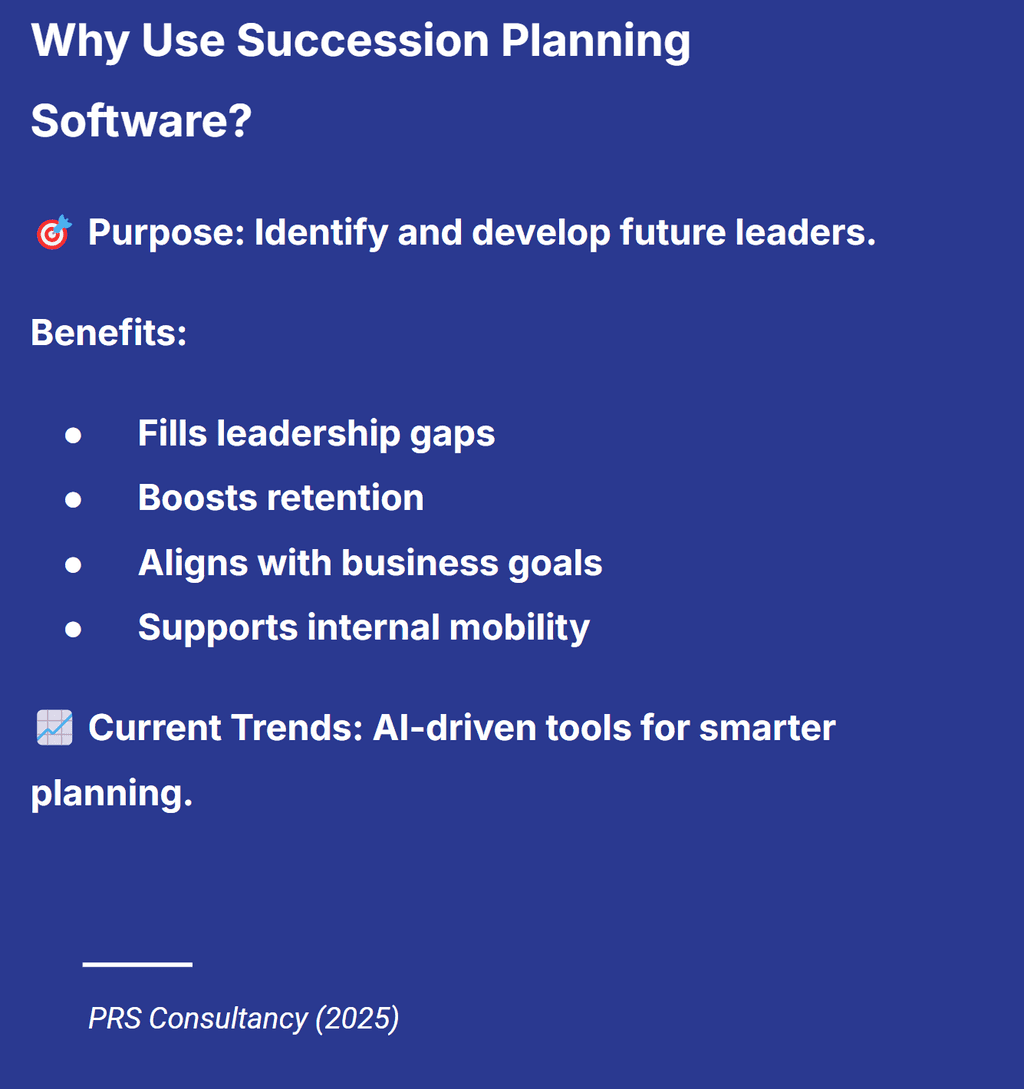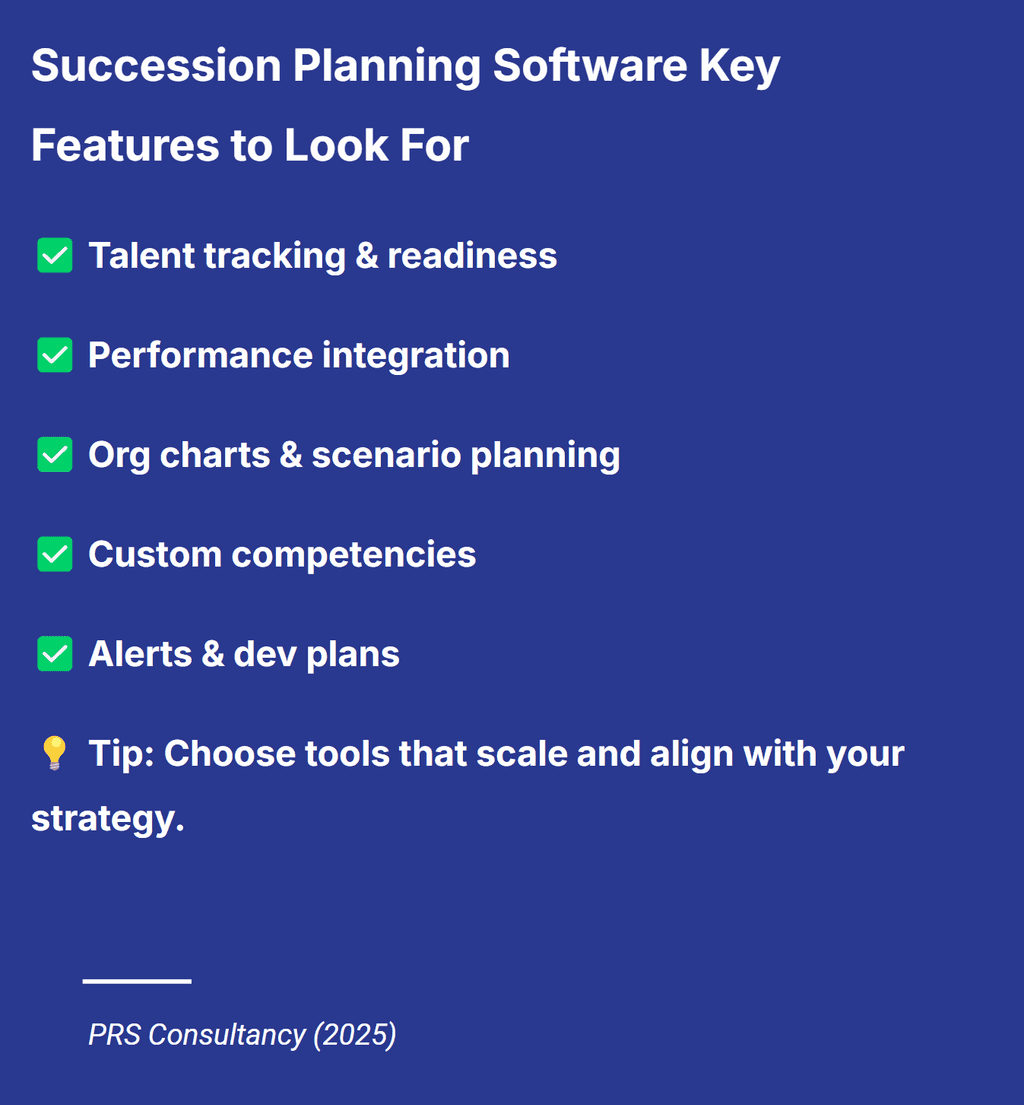Leadership continuity isn't just a nice-to-have—it's a critical component of organizational resilience and long-term success. As someone who has implemented succession planning processes across multiple enterprises, I've witnessed first hand how the right technology can transform this traditionally cumbersome process into a strategic advantage.
While manual succession planning approaches may have sufficed in the past, today's complex organizational structures and rapidly evolving leadership requirements demand more sophisticated solutions. Enter succession planning software—powerful platforms designed to streamline the identification, assessment, and development of your future leaders.
This comprehensive guide explores everything you need to know about succession planning software in 2025: key features, top solutions, implementation strategies, and how to measure ROI. Whether you're an HR professional, executive leader, or talent management specialist, you'll find actionable insights to elevate your succession planning initiatives.
What Is Succession Planning Software and Why Do You Need It?
Succession planning software refers to specialized platforms that help organizations identify, develop, and track potential candidates for key positions. According to [AIHR's "18 Succession Planning Tools and Software [2025 Edition]"](https://www.aihr.com/), these solutions range from basic talent identification tools to comprehensive systems that integrate with broader HR ecosystems.

The Business Case for Succession Planning Software
The statistics make a compelling case:
- Organizations with robust succession planning are 2.5x more likely to outperform their peers financially
- Companies without succession plans face an average cost of $15,000 per day for unfilled critical positions
- 40% of companies report that their leadership pipelines are insufficient for their future needs
As AIHR notes, "Effective succession planning is no longer a luxury but a necessity for organizational sustainability and competitive advantage." The right software transforms this critical function from a periodic, manual exercise to a continuous, data-driven process.
Essential Features of Modern Succession Planning Software
Based on Accendo Technologies' "5 Key Features of Succession Planning Software for Smooth Succession", the most effective platforms share several core capabilities:
1. Talent Assessment and Identification
Modern succession planning software leverages data-driven approaches to identify high-potential employees. Key functionalities include:
- Skills and competency mapping to align employee capabilities with future leadership requirements
- Performance analytics that track historical achievements and potential indicators
- 360-degree feedback tools for comprehensive talent evaluation
- Customizable assessment criteria that align with your organization's specific leadership model
2. Succession Planning Visualization and Modelling
Visual tools help stakeholders understand the current state of the talent pipeline and model potential succession scenarios:
- Interactive org charts with succession data and risk indicators
- Talent pools and bench strength visualization across departments
- Scenario planning tools to model potential organizational changes
- Succession heatmaps highlighting areas of risk
3. Development Planning and Learning Integration
Identification alone isn't enough—the best systems also facilitate development of succession candidates:
- Personalized development plans tied to succession pathways
- Learning management system integration for targeted skill building
- Mentoring and coaching program management
- Development progress tracking with milestone achievements
4. Analytics and Reporting
Data-driven insights are essential for strategic succession planning:
- Succession readiness metrics for individuals and departments
- Talent mobility tracking across the organization
- Risk assessment tools for key positions
- Custom reporting for executive and board presentations
- Predictive analytics for future talent needs
5. Integration Capabilities
According to TechTarget's "10 of the top succession management software products", seamless integration with your HR ecosystem is critical:
- HRIS/HCM system integration for consolidated employee data
- Performance management system connections for real-time evaluation insights
- Recruiting software integration for external talent pipeline building
- Learning management system connectivity for development tracking
- API availability for custom integrations

Top Succession Planning Software Solutions for 2025
Based on comprehensive research across multiple sources including Peoplebox.ai's "Top 10 Succession Planning Tools And Software" and iMocha's "Top 12 Succession Planning Tools to Use in 2025", here are the leading solutions worth considering:
Enterprise-Level Solutions
1. SAP SuccessFactors Succession & Development
Key Strengths:
- Comprehensive talent management suite integration
- Advanced analytics and reporting capabilities
- Global implementation support
- Robust calibration and talent review tools
Ideal For: Large enterprises with complex organizational structures and global presence.
Visit SAP SuccessFactors to learn more.
2. Cornerstone OnDemand
Key Strengths:
- End-to-end talent management capabilities
- Excellent learning and development integration
- User-friendly visual succession planning tools
- Strong mobile capabilities for on-the-go assessment
Ideal For: Organizations prioritizing development alongside succession planning.
Visit Cornerstone OnDemand for more information.
3. Workday HCM Succession Planning
Key Strengths:
- Seamless integration with Workday's broader HCM ecosystem
- Real-time talent data updates
- Powerful analytics and reporting
- Intuitive user interface for all stakeholders
Ideal For: Current Workday customers looking for integrated succession capabilities.
Mid-Market Solutions
4. UKG Pro (formerly Ultimate Software)
Key Strengths:
- Comprehensive talent management functionality
- Strong performance management integration
- Sophisticated succession planning visualization
- Excellent customer support
Ideal For: Mid-sized organizations seeking easy implementation and strong support.
Explore UltiPro for additional details.
5. TalentGuard Succession Planning
Key Strengths:
- Specialized focus on succession and career pathing
- Robust competency frameworks
- Flexible deployment options
- Strong talent development integration
Ideal For: Organizations looking for a dedicated succession planning solution rather than an all-in-one HCM system.
6. Accendo TalentPulse
Key Strengths:
- AI-powered talent analytics and assessment
- Sophisticated success profiles for role planning
- Holistic talent evaluation approach
- Flexible configuration options
Ideal For: Data-driven organizations seeking advanced analytics in their succession planning.
Emerging Players
7. Peoplebox
Key Strengths:
- Modern, intuitive user interface
- Excellent for building leadership pipelines
- Integrated performance and development tools
- Continuous feedback capabilities
Ideal For: Fast-growing companies looking for agile succession planning tools.
8. Arcoro Succession Planning
Key Strengths:
- User-friendly design
- Integrated performance management
- Affordable pricing model
- Excellent for small to medium businesses
Ideal For: Companies implementing formalized succession planning for the first time.
9. PageUp Succession Management
Key Strengths:
- Powerful talent pool management
- Strong candidate readiness assessments
- Scenario modeling capabilities
- Mobile-friendly design
Ideal For: Organizations requiring sophisticated talent pool management across departments.
Implementation Best Practices for Succession Planning Software
DevSkiller's "Succession planning software: Your guide" emphasizes that successful implementation requires more than just selecting the right software. Here's a strategic approach:
1. Establish Clear Objectives First
Before evaluating any software, document your specific succession planning goals:
- What critical roles require succession plans?
- What metrics will define success?
- Who are the key stakeholders in the process?
- How will succession planning integrate with broader talent management?
2. Secure Executive Sponsorship
Succession planning impacts the entire organization and requires top-level support:
- Identify an executive champion
- Establish a governance committee
- Align succession planning with strategic business objectives
- Ensure resource commitment for implementation and ongoing management
3. Take a Phased Implementation Approach
Rather than launching company-wide, consider this progressive approach:
- Phase 1: Implement for C-suite and critical roles
- Phase 2: Expand to senior leadership and specialized technical positions
- Phase 3: Roll out to mid-management
- Phase 4: Extend to high-potential individual contributors
4. Invest in Change Management
According to implementation experts, change management is often the difference between success and failure:
- Develop clear communication plans for all stakeholders
- Provide comprehensive training for managers and participants
- Create detailed process documentation
- Establish a feedback loop to refine the approach
5. Integrate With Existing HR Processes
Succession planning shouldn't exist in isolation:
- Align with performance management cycles
- Connect to learning and development initiatives
- Integrate with talent acquisition for external pipeline building
- Synchronize with compensation planning when appropriate
Measuring ROI: Key Metrics for Succession Planning Software
Implementing succession planning software represents a significant investment. Here's how to measure its impact:
Short-Term Metrics (First Year)
- Implementation efficiency: On-time, on-budget deployment
- User adoption rates: Percentage of managers actively using the system
- Data completeness: Succession plans created for critical roles
- Process efficiency: Time savings compared to previous methods
Medium-Term Metrics (1-2 Years)
- Internal promotion rates for key positions
- Time-to-fill for critical roles
- Bench strength improvement for crucial departments
- Development plan completion rates for succession candidates
- Retention rates for high-potential employees
Long-Term Metrics (3+ Years)
- Reduction in failed leadership transitions
- Decrease in external executive hiring costs
- Leadership diversity improvements
- Business continuity during leadership transitions
- Overall leadership effectiveness ratings
Real-World Success: Case Studies in Succession Planning Software Implementation
Global Manufacturing Company: From Spreadsheets to Strategic Advantage
Challenge: A $4B manufacturing company was managing succession with Excel spreadsheets, resulting in inconsistent data, limited visibility, and cumbersome updates during talent reviews.
Solution: Implemented SAP SuccessFactors Succession & Development with a phased approach starting with executive roles.
Results:
- Reduced time spent on succession administration by 75%
- Increased identification of cross-divisional succession candidates by 40%
- Improved talent review meeting effectiveness through real-time data
- Created developmental assignments for 85% of high-potential employees
Healthcare Network: Building Leadership Resilience
Challenge: A rapidly growing healthcare network with 12 facilities needed to develop leadership bench strength amid industry disruption and competition for clinical leadership talent.
Solution: Deployed Cornerstone OnDemand's succession and development modules with strong integration to their learning platform.
Results:
- Reduced external leadership hires from 65% to 40%
- Decreased time-to-fill for critical roles by 37 days
- Improved leadership retention through identified growth paths
- Created specialized clinical leadership tracks with tailored development plans
Future Trends in Succession Planning Software
As we look toward the future, several emerging trends are shaping the evolution of succession planning software:
1. AI-Powered Talent Assessment
Artificial intelligence is transforming how organizations identify and evaluate succession candidates:
- Predictive algorithms to identify hidden high-potential employees
- Natural language processing for nuanced skill and competency mapping
- Bias detection and mitigation in succession nominations
- Career trajectory modelling based on comparable talent paths
2. Skills-Based Succession Planning
The traditional role-to-role succession model is evolving toward a more fluid, skills-based approach:
- Dynamic skill inventories that update based on project work and learning
- Critical skill gap analysis across the organization
- Skill adjacency mapping to identify unexpected succession candidates
- Agile talent deployment based on evolving business needs
3. Experience-Focused Development
Modern succession planning software increasingly focuses on experiential development:
- Project marketplace integration for developmental assignments
- Gig work platforms for internal talent mobility
- Quantification of experience acquisition through work
- Simulation and scenario-based leadership assessment
4. Real-Time Succession Planning
The annual succession planning cycle is giving way to continuous processes:
- Always-on talent data collection and analysis
- Dynamic succession plans that update with organizational changes
- Continuous feedback integration for ongoing readiness assessment
- Regular talent marketplace updates rather than point-in-time reviews
Choosing the Right Succession Planning Software: A Step-by-Step Guide
With so many options available, selecting the right succession planning software requires a systematic approach:
Step 1: Assess Your Organization's Maturity and Needs
- Current state analysis: How sophisticated are your existing succession processes?
- Scale considerations: How many employees and critical roles need coverage?
- Integration requirements: What existing HR systems must connect to your succession solution?
- Budget parameters: What investment level is appropriate for your organization?
Step 2: Develop Clear Requirements
Document specific requirements across these categories:
- Essential features: Must-have capabilities for your succession process
- User experience: Accessibility and usability needs for different stakeholders
- Technical specifications: Hosting preferences, security requirements, integration needs
- Support and services: Implementation assistance, training, and ongoing support expectations
Step 3: Evaluate Top Contenders
Create a structured evaluation process:
- Request detailed demos focused on your specific use cases
- Involve key stakeholders in the evaluation process
- Check references from similar organizations
- Consider pilot programs where appropriate
Step 4: Assess Total Cost of Ownership
Look beyond the initial license fees to understand complete costs:
- Implementation services and customization
- Annual subscription or maintenance fees
- Internal resources required for management
- Additional modules or capabilities that may be needed later
Step 5: Plan for Success
Before final selection, create a comprehensive implementation roadmap:
- Establish realistic timelines
- Assign internal resources
- Develop change management strategies
- Create success metrics and evaluation frameworks
Common Pitfalls to Avoid When Implementing Succession Planning Software
Based on real-world implementation experiences, here are critical mistakes to avoid:
1. Treating It as an HR-Only Initiative
Succession planning impacts the entire organization and requires broad involvement:
- Engage business leaders in requirements gathering
- Include finance, IT, and operations in selection committees
- Design processes that work for line managers, not just HR
- Ensure executives are active users, not just recipients of reports
2. Focusing on Software Before Strategy
The technology should enable your strategy, not define it:
- Establish clear succession planning principles and processes first
- Document your ideal workflow before evaluating software
- Prioritize flexibility to accommodate future process evolution
- Avoid customizing your process to fit software limitations
3. Neglecting Data Quality
Even the best software fails without quality data:
- Conduct data cleansing before migration
- Establish data governance standards
- Create clear accountability for data maintenance
- Implement validation processes for critical succession data
4. Insufficient Training and Support
User adoption makes or breaks succession planning software:
- Develop role-based training programs
- Create job aids and quick reference guides
- Establish an internal support team
- Schedule regular refresher training, especially around talent review cycles
5. Ignoring Privacy and Ethical Considerations
Succession planning involves sensitive employee information:
- Establish clear data access protocols
- Consider legal implications in different jurisdictions
- Be transparent with employees about how data is used
- Create ethical guidelines for AI and predictive analytics
Conclusion: The Strategic Advantage of Modern Succession Planning Software
In today's rapidly evolving business landscape, leadership continuity isn't just an HR concern—it's a strategic imperative that impacts every aspect of organizational performance. The right succession planning software transforms this critical function from a periodic administrative task to a continuous strategic advantage.
By implementing a modern succession planning platform, organizations can:
- Reduce the risks associated with leadership transitions
- Accelerate the development of high-potential talent
- Improve engagement and retention of future leaders
- Create more diverse and prepared leadership pipelines
- Enhance organizational resilience and continuity
As you consider your options, remember that successful implementation depends on more than just selecting the right technology. It requires clear strategy, executive sponsorship, change management, and ongoing commitment to the process.
The investment in sophisticated succession planning software pays dividends not just in smoother leadership transitions, but in creating a culture of growth, opportunity, and organizational resilience that positions your company for long-term success.
FAQs About Succession Planning Software
How much does succession planning software typically cost?
Pricing varies widely based on organization size and feature requirements. Simple solutions start around $5-10 per employee annually, while enterprise platforms with comprehensive capabilities typically range from $15-40 per employee annually. Most vendors offer tiered pricing based on modules implemented and total employee count.
Can succession planning software integrate with our existing HRIS?
Most modern succession planning platforms offer pre-built integrations with popular HRIS systems like Workday, ADP, and SAP. For custom or legacy systems, look for vendors that provide robust API capabilities and integration services. During vendor evaluation, provide specific integration requirements and request technical demonstrations of your critical integration points.
How long does implementation typically take?
Implementation timelines range from 4-8 weeks for basic configurations to 3-6 months for complex enterprise deployments. Factors affecting timeline include data complexity, integration requirements, customization needs, and change management considerations. A phased approach often yields the best results, starting with critical roles and expanding to broader populations.
What internal resources are required to manage succession planning software?
Most organizations designate a system administrator (typically 0.25-0.5 FTE) to manage configuration, updates, and user support. Additionally, HR business partners or talent management specialists typically support process execution. The level of IT involvement varies based on integration complexity and security requirements. Ongoing success requires clear ownership of both the system and the underlying succession process.
How can we ensure manager adoption of the system?
Successful adoption requires a multifaceted approach: 1) Involve managers in requirements gathering to ensure the system meets their needs, 2) Develop intuitive interfaces that minimize administrative burden, 3) Provide targeted training with role-specific examples, 4) Create clear accountability through executive sponsorship, and 5) Demonstrate value by sharing insights and outcomes from the succession process.
About the Author: This comprehensive guide was developed by a talent management expert with over 15 years of experience implementing succession planning systems across industries. The insights are based on real-world implementations, research, and best practices from leading organizations.
Last Updated: March 2025
